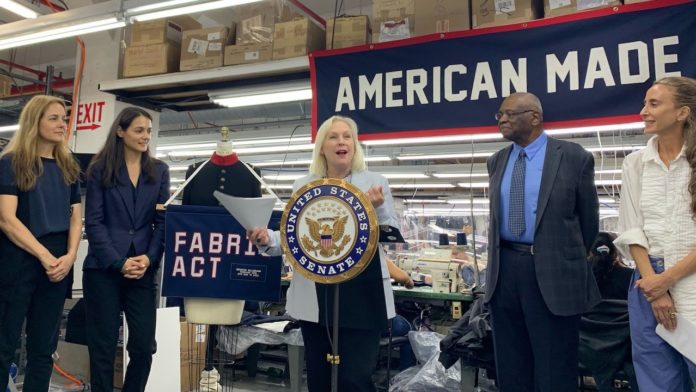“So, we can not only make American, but buy American…”
Senator Kirsten Gillibrand of New York announced a new bill few weeks ago that would address labour problems and worker rights in the US textile sector. Senators Cory Booker (D-NJ), Elizabeth Warren (D-MA), and Bernie Sanders (D-VT) co-sponsored the Fashioning Accountability and Building Real Institutional Change (FABRIC) Act, which was introduced to the Senate on May 12.
The legislation comes as a response to the increasingly unsafe working conditions often endured by American workers, with a press release from the senator stating that the pandemic has only emphasised these issues further.

The next day, she held a press conference in New York City’s Garment District, speaking alongside Mara Hoffman, Workers United’s Edgar Romney, Remake’s Ayesha Barenblat, Ferrara Manufacturing’s Gabrielle Ferrara and Teresa Garcia of the Garment Worker Center of Los Angeles about the importance of this bill.
“Every single day, every one of us starts the morning getting up and getting dressed. ‘What are we going to wear?’ But the question we don’t ask ourselves is, ‘What did it take to make the clothes that I’m going to wear?’ The answer to that question is an answer we don’t want to hear,” she told the small crowd gathered on the floor of Ferrara Manufacturing. “The reality is that the people who make our clothes are too often not employed fairly or treated fairly or paid fairly for their work in an industry that’s vital to our economy and our daily lives. It’s an unacceptable reality that we have to address head-on.
“It’s time to take bold action at the federal level to change the fabric of the American manufacturing industry,” said Gillibrand, in a speech. “The US was once home to a booming apparel manufacturing industry, and it’s time to re-examined how this industry has evolved over the past 50 years and change how we treat our workers.”
Sen. Gillibrand noted how, while the tragic Triangle Shirtwaist Factory fire in 1911 brought attention to unsafe work conditions in the fashion industry and led to legislation, little has been done since on the policy front — even though many of those issues persist 111 years later.
“This legislation will help ensure that when we go to our closets in the morning and look for something to wear, we can find clothes that were actually made in America and made fairly,” Sen. Gillibrand said.
"These measures are going to change the game."
What would the FABRIC ACT Do?
The FABRIC Act focuses on five main areas: ending “piece rates,” creating productivity incentives for workers on top of hourly minimum wage pay; instituting liability measures for brands that hold them and their manufacturing partners accountable for their labour practises; establishing new record-keeping and transparency measures, such as a national registry of garment manufacturers at the Department of Labor; and encouraging brands to bring their garment manufacturing back to the United States.
You can read the full text of the bill on Sen. Gillibrand’s website.
The FABRIC Act will amend the Fair Labor Standards Act, which was introduced in 1983 and set the standards for the protection of workers in the garment industry.
Since its inauguration, the renewed FABRIC Act has been met with a cohort of positive support from the industry, including a wide number of designers, organisations and manufacturers that have each expressed their approval of the legislation
“Fashion Revolution USA is proud to endorse the FABRIC Act,” said Nikki Eclarinal, policy manager of Fashion Revolution USA, in a statement. “As the nation’s first federal fashion bill, the FABRIC Act is rooted in improving the lives of thousands of garment workers, increasing supply chain transparency, and holding brands responsible for unethical labour practices.”
Eclarinal continued: “By supporting the FABRIC Act, we ensure that people, human rights, and dignity are central to fostering a more sustainable and transparent future in fashion.”
Also read: Textile Fiber Innovations – Enter the New Era of Textile Production













